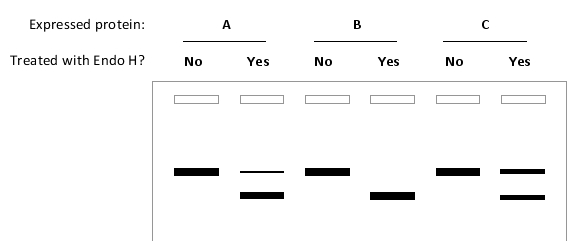You know that a particular sequence at the C-terminus of the lectin ERGIC53 enhances its exit from the endoplasmic reticulum (ER). You create two mutant versions of the protein, one without the suspected sequence (1) and one in which the sequence is replaced with an ER retention signal (2). You transfect a fibroblast cell line with a plasmid that encodes either wild-type ERGIC53 (0) or one of the engineered versions of it (1 or 2). After inducing the expression of the proteins, you lyse the cells and either treat the lysate with endoglycosidase H (Endo H) or leave the lysate untreated, as indicated below. You then separate the proteins by SDS-PAGE and perform a Western blot to detect the bands corresponding to ERGIC53. Your results are represented in the following drawing. Which lanes (A to C) do you expect to correspond to each of the proteins 0, 1, and 2, respectively? Your answer would be a three-letter string composed of letters A to C only, e.g. CAB.

Definitions:
Larger Firms
Businesses or companies that have a significant scale in terms of operations, revenue, and workforce size, often with a broad market presence.
Business Decisions
Choices or judgments that are made in the course of managing a business, considering various factors to achieve organizational goals.
Q13: Unlike a myosin head, a kinesin head
Q17: Which of the following graphs better represents
Q21: The nicotinic acetylcholine receptor is a cation
Q28: The sequence of a region of DNA
Q28: Consider two mammalian cells, one in G₁
Q34: Indicate whether each of the following descriptions
Q45: Some photosynthetic bacteria have only one type
Q46: Which of the following probably occurred first
Q54: Indicate whether each of the following conditions
Q66: The binding of protein A to two